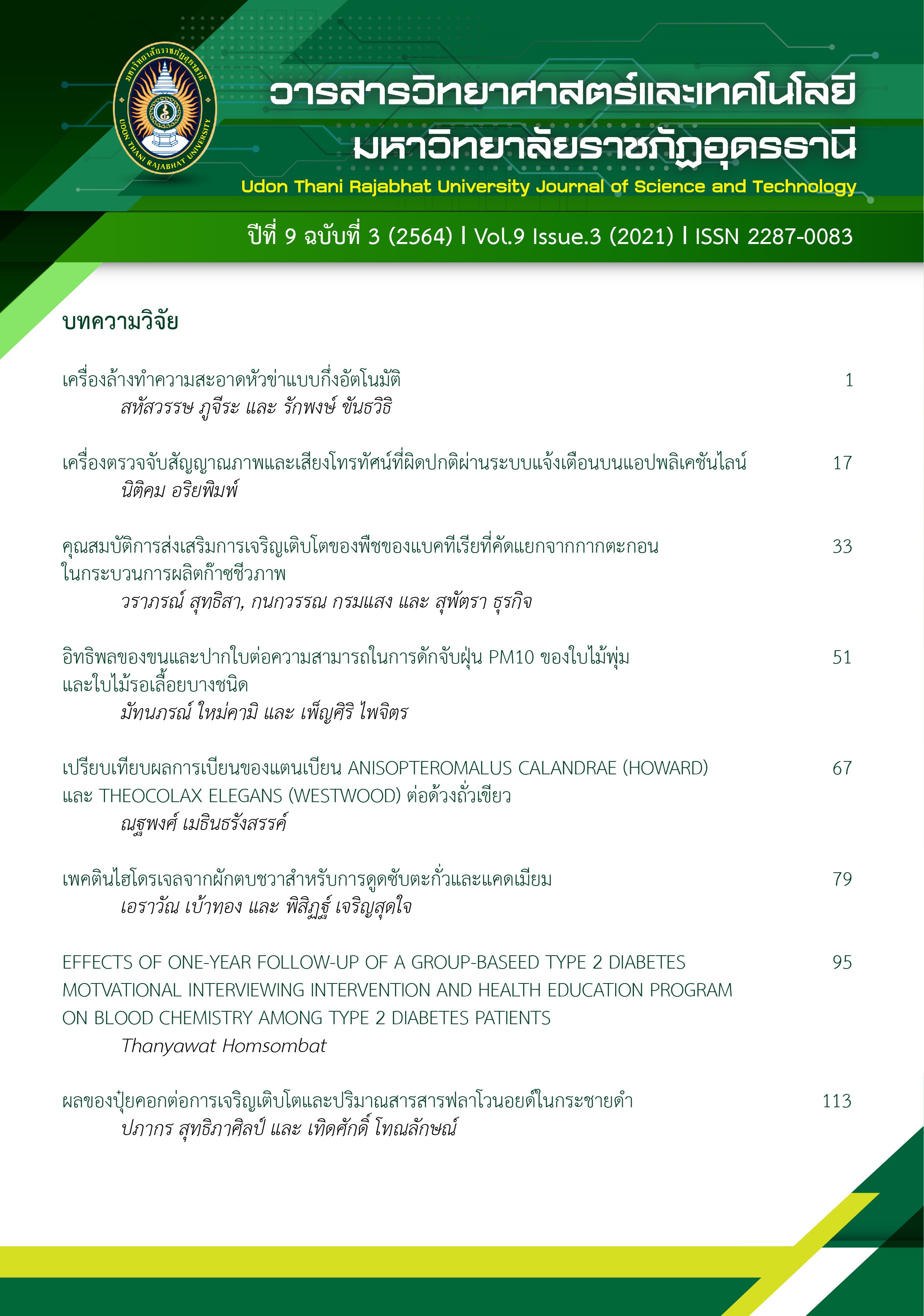เพคตินไฮโดรเจลจากผักตบชวาสำหรับการดูดซับตะกั่วและแคดเมียม
Main Article Content
บทคัดย่อ
งานวิจัยนี้มีวัตถุประสงค์ในการศึกษาการดูดซับตะกั่วและแคดเมียมโดยใช้เพคตินไฮโดรเจลที่สกัดจากผักตบชวาที่มีร้อยละหมู่เอสเทอร์เท่ากับ 94.13 ในสารละลายที่มี pH 1.00 – 6.00 ศึกษาเวลาในการดูดซับ 0 – 1,440 นาที ที่อุณหภูมิ 25 oC ความเข้มข้นของตะกั่วและแคดเมียมในน้ำเท่ากับ 100 mg/L ใช้สมการแลงเมียร์และฟรุนดริชในการอธิบายสมดุลการดูดซับ ผลการวิจัย พบว่า ค่าความสามารถในการดูดซับตะกั่วและแคดเมียมของ เพคตินไฮโดรเจลจะมีประสิทธิ รูปสูงสุดที่ pH เท่ากับ 4.00 มีค่าความสามารถในการดูดซับ (qe) ตะกั่วและแคดเมียมเท่ากับ 66.98 mg/g และ 58.96 mg/g ตามลำดับ ปัจจัยด้านเวลา พบว่าเวลาที่เหมาะสมที่สุดในการปลดปล่อยตะกั่วและแคดเมียมจากเพคตินไฮโดรเจลคือ 60 นาทีมีค่าความสามารถในการปลดปล่อยตะกั่วและแคดเมียมมากที่สุดเท่ากับร้อยละ 67.80 และ 70.44 ตามลำดับ ในด้านของไอโซเทอร์มการดูดซับตะกั่วและแคดเมียมของเพคตินไฮโดรเจลสอดคล้องกับสมการแลงเมียร์มากกว่าสมการฟรุนดริช โดยมีค่าสัมประสิทธิ์สหสัมพันธ์ (R2) ของไอโซเทอร์มสมการแลงเมียร์ของตะกั่วและแคดเมียมเท่ากับ 0.97 และ 0.99 ตามลำดับ
Article Details
เอกสารอ้างอิง
เอราวัณ เบ้าทอง. (2561). แนวทางการใช้ประโยชน์เปลือกทุเรียนผสมเปลือกมะพร้าวในการสกัดเพกทิน. วารสารหน่วยวิจัยวิทยาศาสตร์เทคโนโลยีและสิ่งแวดล้อมเพื่อการเรียนรู้, 9(2), 200-210.
Bhattacharyya, A., O’Bryan, C., Ni, Y., Morley, C. D., Taylor, C. R., & Angelini, T. E. (2020). Hydrogel compression and polymer osmotic pressure. Biotribology, 22, Doi.org/10.1016/j.biotri.2020.100125.
Carlini, M., Castellucci, S., & Mennuni, A. (2018). Water hyacinth biomass: chemical and thermal pre-run for energetic utilization in anaerobic digestion process. Energy Procedia, 148, 431-438.
Jakobik-Kolon, A., Milewski, A. K., Mitko, K., & Lis, A. (2014). Preparation of pectin-based biosorbent for cadmium and lead ions removal. Separation Science and Technology, 49, 1679–1688.
Kaushik, P., Priyadarshini, E., Rawat, K., Rajamani, P., & Bohidar, H. B. (2020). pH responsive doxorubucin loaded zein nanoparticle crosslinked pectin hydrogel as effective site-specific anticancer substrates. International Journal of Biological Macromolecules, 152, 1027-1037.
Lessa, E. F., Medina, A. L., Ribeiro, A. S., & Fajardo, A. R. (2020). Removal of multi-metals from water using reusable pectin/cellulose microfibers composite beads. Arabian Journal of Chemistry, 13(1), 709-720.
Levigne, S. M. C., Ralet, J., & Thibault., F. (2002). Characterisation of pectins extracted from fresh sugar beet under different conditions using an experimental design. Carbohydrate Polymers, 49, 145-153.
Naohara J., & T. Ishii. (1989). Contents of Pectic Substances in Water Hyacinth. Nippon Shokuhin Kogyo Gakkaishi, 36(7), 583-589.
Shukla, R. N., Bala, K. L., Kumar A. A., Mishra, A., & Yadav, K. C. (2014). Extraction of pectin from citrus fruit peel and its utilization in preparation of jelly. International Journal of Engineering Research & Technology, 3(5), 1925-1932.
Thakur, S., Chaudhary, J., Kumar, V., & Thakur, V. K. (2019). Progress in pectin based hydrogels for water purification: Trends and challenges. Journal of Environmental Management, 238, 210-223.
Wang, R., Li, Y., Shuai, X., Liang. R., Chen, J., & Liu, C. (2021). Pectin/Activated Carbon-Based Porous Microsphere for Pb2+ Adsorption: Characterization and Adsorption Behaviour. Polymers, 13, Doi.org/10.3390/polym13152453.
Wang, R., Liang, R., Dai, T., Chen, J., Shuai, X., & Liu, C. (2019). Pectin-based adsorbents for heavy metal ions: A review. Trends in Food Science & Technology, 91, 319-329.
Weiping, S., Qingping, S., Meisheng, X., Zhengshun, W., & Zhitong, Y. (2018). The Resource Utilization of Water Hyacinth (Eichhornia crassipes [Mart.] Solms) and Its Challenges. Resources, 7(3), 1-9.


